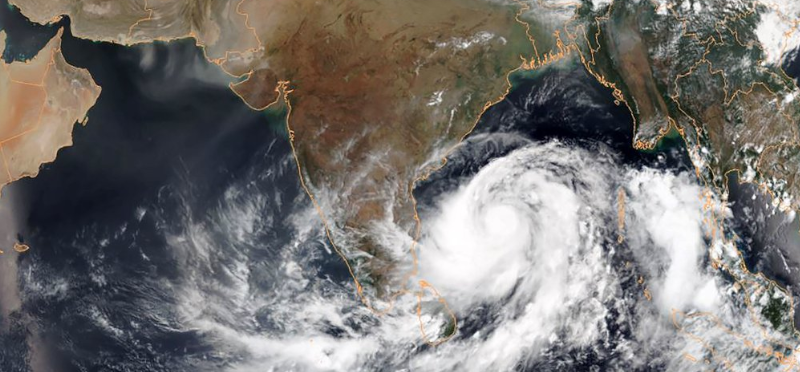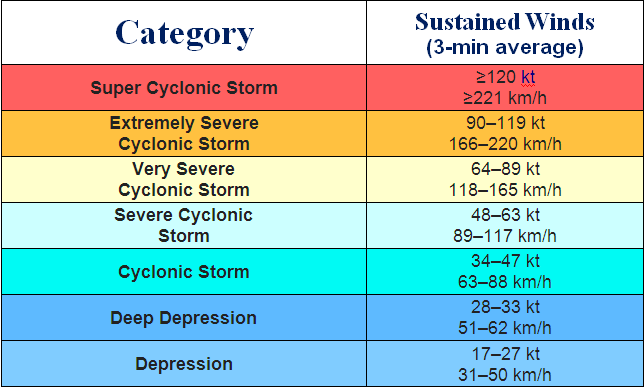
The Cyclone ‘Fani’ which has started its journey from South-East Bay of Bengal has finally made a landfall in Odisha after more than 10 days at sea.
How Fani Got Its Name?
- Historically, the names of certain cyclones get registered in the memory of people because of their destructiveness and the vast media coverage.
- The HudHud cyclone in 2014, Ockhi in 2017, Titli and Gaja in 2018 are some examples.
- In general, tropical cyclones were not named. The naming began with the Hurricanes in the Atlantic with the US adopting a naming system.
- The naming system for tropical cyclones in the Indian Ocean began in 2004.
- Eight countries of the Bay of Bengal and Arabian Sea region agreed upon a rotating naming system for cyclones occurring in these seas.
- The eight countries are Bangladesh, India, Myanmar, Oman, Maldives, Pakistan, Sri Lanka, and Thailand.
- All these are members of the group WMO/ESCAP.
- The countries submitted their names which are arranged in an 8×8 table.
- Each country is allocated a row and eight names are arranged and a total of 64 names will be present in the table.
- The naming of the cyclone goes column-wise.
- The name ‘Fani’ was proposed by Bangladesh.
- The next name will be named ‘Vayu’ which is proposed by India.
- Once the names in the list are exhausted, the eight countries will propose a fresh set of names.
Difference with Atlantic Naming
- Unlike the Naming list of Hurricanes in the Atlantic which is rotated every few years, the name list of cyclones in the Indian Ocean is new every time.
- But, there are some exceptions made to the Atlantic list.
- Hurricanes that cause excessive death and destruction are retired from the list and are replaced by new ones.
Why Name Cyclones At All?
- Naming a cyclone makes it easy to report it in the media.
- Also, technical terms and numbers which were used earlier are difficult to communicate.
Criteria
- As per the Regional Specialized Meteorological Centre (RSMC) of Indian Meteorological Department (IMD), the general public can propose a name to be included in the list.
- But, it must follow certain criteria – the proposed name should not be culturally sensitive; it should be easy to communicate when broadcasted; and it should not have an inflammatory meaning.
Tropical Cyclones
- Tropical Cyclones are massive rotating storm systems.
- They have a low-pressure centre called the ‘eye of the storm’.
- The winds in a tropical cyclone blow in a counterclockwise direction in the Northern hemisphere and clockwise in the southern hemisphere.
- Coriolis force plays an important role in the formation of these cyclones.
- Thus, these cyclones are formed in latitudes between 10 and 30 degree N and S of the equator.
- They are not formed near the equator as the Coriolis force is zero at the equator.
- A depression first emerges in the sea and then transforms into a tropical cyclone.
- It then moves towards the land where there is low pressure and makes landfall.
- Tropical cyclones bring with them destructive forces – high-speed winds, sea surge, and torrential rains.
Categories of Cyclones:
- The IMD uses seven different classifications for cyclones within the Indian Ocean.
- They are based on the sustained wind speeds of the storm system.
- The classifications are as below:

- ‘Fani’ was classified as Extremely Severe Cyclonic Storm. Second highest category classification.
East Coast and Cyclones:
- In India, April to December is the cyclone season and a large number of cyclones occur between September and December.
- The east coast of India is majorly impacted by the cyclones.
- Especially Tamil Nadu, Andhra Pradesh, and Odisha bear the brunt of cyclones occurring in the Bay of Bengal.
- On the west coast, the Arabian Sea rarely generates cyclones.
- This is majorly due to the wind pattern on the Bay of Bengal and a flatter topography that could not deflect a storm system on to the sea like the Western Ghats on the West Coast.
Also Read:
- The Threat of Superbugs Looming Large On The World
- SDG India Index and Surprising Results
- Ultrasensitive Quantum Thermometer – Developed by JMI Indian Scientists
Conclusion:
- Cyclones have been a major disaster causing weather events for India since time immemorial.
- But the amount of disaster that the Cyclones have increased by manifold due to rising population and the infrastructure that is in the line of sight of a storm.
- Climate change due to rising temperatures is becoming an important reason for the increase in the intensity of these storms.
- There is no way to stop them from occurring, but governments can take precautionary measures with advanced warning systems to avoid any loss of life.
- Since, the deadly tropical cyclone of 1999 which left a trail of death and devastation, India has come a long way in saving lives and minimizing the death toll.
- Now, governments have to improve upon post-disaster response in the speedy clearing of debris and allowing the public to pursue their livelihoods at the earliest.

Leave a Reply
You must be logged in to post a comment.